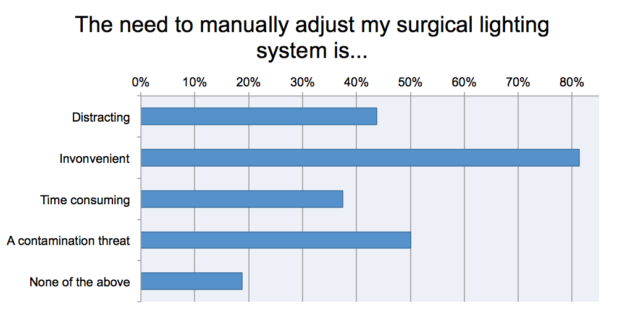A little more than a year ago, I found myself in the back seat of a car with Brody King. After discussing our previous business experiences and aspirations, he told me a story:
“I was shadowing a surgeon when I noticed that he was frequently adjusting the overhead light. I actually ended up stepping on a stool, grabbing the light, and adjusting it for the surgeon in real time as the procedure progressed.”
The very next week we were building SyboT, a robotic surgical light. Sometimes the best way to search for ideas is by not searching at all.
Aspiring entrepreneurs devote too much time chasing the perfect idea. This is merely a symptom of fear, and being afraid to fail is outdated. Today’s innovators embrace the strategy of failing fast.
No one likes to fail, but according to Forbes, 80 percent of startups crash and burn within just 18 months. If the odds are stacked against us, why not fail fast? Nothing develops an individual quite like failure, and doing so will enable us to move on to the next idea armed with a sharpened awareness.
In fact, Henry Ford said, “The only real mistake is the one from which we learn nothing.” Embrace failure while working to avoid it. Applying the scientific method to the entrepreneurial process is a way to work systematically while failing fast. Here are the seven steps to bring your company into the “successful” 20 percent:
1. Define a Question
All too often, entrepreneurs spend months or even years developing a product or service that no one wants. To prevent this pitfall, define a question that the entire development strategy hinges on. Then narrow the scope by asking a more specific question. Elon Musk’s first question was: “What would most affect the future of humanity?”
His answer has since become space exploration and leads to yet another question: “How can we send people to Mars?”
It turns out SpaceX must first reduce the cost of space missions by reusing rockets. Doing so will eliminate the need to develop an entirely new $60 million stage-one vehicle and require as little as half a million dollars to repair and refuel.
2. Gather Information & Resources
“The more I learn, the more I realize how much I don’t know” – Albert Einstein
To build a successful company, you need to become an expert in your industry first. Looking to past and present experts is a great way to do this. Since the start of Sybo Technology, we have spoken to 82 industry professionals. Each one provides further product validation with a unique perspective. With their guidance, we have received clarity on what we need to do.
Most of our success with this is due to our friends and family, the Lassonde Entrepreneur Institute and social networks such as LinkedIn. Who would be beneficial for you to talk to? You’d be surprised at how many people are willing to give advice to students. Schedule a phone call with them, prepare a list of questions and be yourself.
Obtaining education, consulting industry experts and performing market research should all be done before taking a risk.
3. Form an Explanatory Hypothesis
Our team of seven hypothesized that by automating the light adjustment process, surgeons and staff would achieve greater efficiency and enhanced focus on the patient during procedures.
The medical lighting industry has been largely void of innovation for over two decades. With the global medical lighting market expected to grow from $555 to $729 million in the next four years, we believe there is a disruption opportunity.
Without a hypothesis, it is difficult to abandon popular assumptions. To quote material from the U’s Department of Entrepreneurship and Strategy: “When scientists and entrepreneurs are not prepared to abandon status quo assumptions about the problem they are trying to solve, they will likely arrive at the same solutions as everyone else.”
4. Experiment Relentlessly
Our first experiment was a simple surgeon survey of just 12 questions. Of those surveyed, 87.5 percent said they would benefit from using an automated light.
This was good feedback, but when we brought up the potential to reduce RSIs (retained surgical items) by automatically tracking surgical instruments they lit up. In fact, a whopping 90.4 percent said automated instrument tracking would benefit them as well.
While this is far from tracking the operating outcomes associated with using our device, we have positive data indicating interest in our market. At least for now, we can think we have a viable product.
To narrow the scope of our initial product to just two main benefits, we focused on the minimum viable product, or MVP.
The MVP is the sweet spot between the two extremes of minimum and viable. For startups to control their burn rate while providing value, it is important to focus on the features or benefits that are most important to potential customers. It’s about making a product viable while staying in business.
5. Analyze the Data
During the experimentation phase, it’s important to actively record your results. Barclay Burns, a professor of Entrepreneurship and Strategy at the University of Utah, pioneered a method of analysis effective at analyzing both qualitative and quantitative data. He breaks the analysis into “Five Types of Value”:
- Value in Use – User experience is extremely enticing and enjoyable. Consumers will not only crave it again, but will also tell their friends about it.
- Value in Exchange – Created when the service is offered at a competitive price point.
- Value in Distribution – Is the service widely available and accessible?
- Value in Finance – The financial health of the organization. Can it provide a high value in exchange while maintaining healthy margins?
- Value in Fitness – Maintained by continually gathering resources and innovating.
Focus the most attention on the “Value in Fitness”; this will directly affect the performance of all other values in the near future. For example, Google has an excellent “Value in Fitness” that facilitates high values in use, exchange and distribution.
6. Interpret the Analysis of Results
It is important to first validate sources, review assumptions and question any data collected. Conclusions can be drawn once the accuracy of the data is determined. What is the answer to the beginning question? What are the implications of this answer? These implications will drive further research. We received the following input from the surgeons we surveyed:
Our hypothesis from step three may still be correct, but we now know that the surgeon’s true pain point is inconvenience during procedures. Sybo is now focused on making the staff’s job easier and more enjoyable, while also providing a safer, more efficient system that hospital administrators can justify.
7. Publish Results
This can take many forms depending on the project. For SpaceX this was likely live video streams of stage one rocket landing attempts. For us it will consist of having surgeons and staff demo SyboT.
Regardless of the feedback, embrace it. This is only another opportunity to validate your market. Be prepared to move on to the next opportunity or to ramp up production and begin marketing your product/service.
Citation note: Much of the material has been adapted from the ENTP 1020 class that I participated in two years ago and for which I have since been an active TA. Go to gotentrepreneurs.com for a detailed breakdown of the scientific method and the associated cases.






Every businessman has their career as a “ENTREPRENEUR”. After becoming as great “ENTREPRENEUR” they are known as a Businessman. This is also a scientific method.